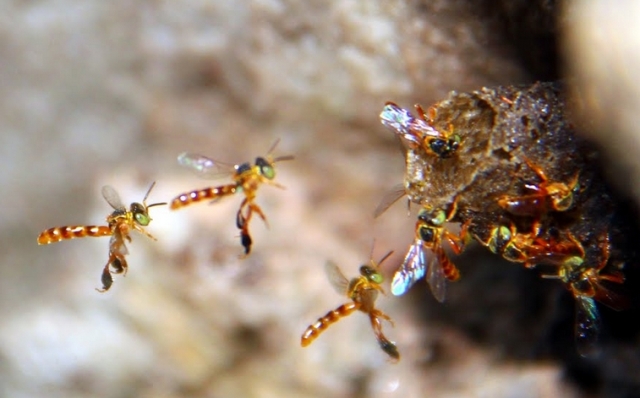
This week, we should celebrate Warwick Estevam Kerr, the man who made the killer bees. September 9th is his 95th birthday. Just like his bees, Kerr comes from hot, tropical Brazil. And just like his bees, Dr Kerr has been much maligned and misunderstood in the popular press. But Kerr did more to help his country’s agriculture than perhaps any other individual.
When the Africanized hybrid honey bee entered our awareness in the 1970s, the bee was described as a killer bee (in Brazil, they called it the assassin). The man who brought African honey bees to South America was turned into a mysterious fiend who had “disappeared from sight” after “he turned killer bees loose”. Well, he did disappear for a while. He was in prison. But not for any reason you might guess. First, some background.
What was Kerr’s crime?
Dr Warwick Kerr brought Africanized genetic stock to South America in 1956. In today’s context, importing an alien creature from another continent seems horribly reckless. In Dr Kerr’s day, the importation of bees from Africa was hardly daring. First, recall that all honey bees in the Americas are imported from somewhere else. Honey bees are not native to the western hemisphere. Second, Kerr was not introducing a new species. The African bee (Apis mellifera scutellata) is a cousin of a common European honey bee, Apis mellifera iberiensis, which was in Brazil when the African queen bees arrived. Kerr’s importation of 26 queen bees from Tanzania is in league with importing Clydesdales long after Arabians and Morgans were already established. Kerr’s goal was to improve the non-tropical honey bees which farmers were using in Brazil. He rightly assumed that tropical genetic stock would be more successful in his tropical country.
Warwick Kerr’s sour reputation came directly from the Brazilian government. Although he was a geneticist and was at first entrusted with developing a better bee for Brazil’s farmers, the Brazilian military dictatorship attacked Kerr’s stand on civil rights. He was imprisoned in 1964 when he publicly fought government corruption. In 1969 he was re-arrested, this time for protesting that Brazilian soldiers who had raped and tortured a nun went unpunished. Sister Maurina Borges, who ran the Ribeirão Preto Orphanage, was an activist; the soldiers were part of Brazil’s military dictatorship, committing crimes encouraged by the government. [See page 16 of this 2005 interview with Kerr.] Most of the western press didn’t bother to investigate the reasons behind the Brazilian government’s dismissal of Kerr’s work, his qualifications, or his imprisonment.
Creating a clown
All of this is lost on most people who write about this subject. For example, this is from a blog promoting a book called The Animal Review: A Report Card. The writer calls Dr Kerr a clown:
“It is strange and unfortunate that there is not a Nobel Prize for Really Bad Mistakes In Science. This international award could be presented annually in Stockholm by a sad clown wearing a lab coat and goggles, giving scientists that much more of an incentive to get things right for once. Brazilian geneticist Warwick Estevam Kerr would have made a fine nominee. For it was Mr. Kerr who introduced Africanized honey bees (Apis mellifera scutellata) to the Americas. Oops. Bring in the clowns…
“The full scope of the blunder was not immediately apparent to Kerr. Being a brilliant geneticist, he brilliantly assumed the African queen fugitives would breed with feral bees — thus diluting their infamous aggression.
“But on the bright side, Africanized honey bees pollinate plants and plants are crucial to agriculture production everywhere in the blah, blah, blah, blah.”
” Warwick Estevam Kerr, Grade: F- ”
Almost everything in the preceding story is wrong, but I put it here to illustrate how the popular press saw Dr Kerr – a clown deserving an F- grade. In fact, it’s the lazy reporters who earn a big fat Fail.
Here’s another example: National Geographic blunders portraying Dr Kerr in their 2006 documentary, Attack of the Killer Bee. “Incredibly, nearly one trillion killer bees can all be traced back to just one man…” [I’ll bet you know who they’re talking about.] In Africa, says NG, Kerr “chose the best specimens he could find, but he noticed something disturbing.” (At this point, the actor playing Kerr gets stung on the finger and yelps “Ouch!” in pain. “Doctor Kerr was wrong. Very wrong. And the western hemisphere is still paying a steep price.” This is verbiage that sells, even if utterly wrong.
You should watch the first few minutes of the following NG fantasy. The devilish portrayal of the black Africans who sold Kerr the ‘deadly’ bees is also vile racist National Geographic reporting, but that’s fodder for a whole different story. I have the video below queued up to start at 3 minutes – that’s where an actor playing Kerr gets ready to leave for Africa. Don’t bother to watch more than a minute or two of this.
The Killer Bees
Warwick Kerr was responsible for bringing African genetic stock to Brazil in 1956. As a geneticist, he wanted to improve the health and hardiness of the European honey bee which came from Portugal in 1834. That European strain was poorly adapted to the tropics, so the Italian honey bee (Apis mellifera ligustica) was imported in the 1880s, but it wasn’t much better. A few farmers and monks kept the languid bees, mostly to collect beeswax for church candles.
In 1956, Brazil’s annual honey production from the European honey bees was just 15 million pounds. Brazilian agriculture was expanding and needed a tropical honey bee for pollination and honey production. After the African bees arrived, Brazil’s beekeepers produced 110 million pounds. Brazil went from 43rd in the world to 7th largest honey producer. By 1994, L.A. Times headlined: “Brazil’s honey production has soared since the ornery invaders took over beekeepers’ hives”. Today, most of the world’s organic honey is produced by Africanized honey bees in Brazil’s remote forests. The honey is doubly organic – produced in areas untouched by pesticides and produced in Africanized hives which are naturally resistant to varroa – so mite meds aren’t used in those colonies.
Honey bees with African genes are more aggressive than European bees. Beekeepers in Brazil had to learn appropriate management techniques. Although the venom is the same, more bees attack if their colony is disturbed. People have died from massive stings. Those deaths are sorrowful and this story about Dr Kerr’s bees should not dishonour personal tragedies. Some of the traits which make Africanized bees exceptional pollinators (refined olfactory sense, quicker movements, flights in inclement weather, superior navigation skills) also make them more likely to sting. However, they can be managed by farmers and beekeepers. Indiscriminate killers they are not.
Decoding sex among stingless bees
At first, Warwick Kerr worked with Melipona bees, not honey bees. Some of Brazil’s poor and indigenous were wild honey gatherers, or meleiros. Meleiro, isolated and rural, is named for the meleiros, who are named for Melipona honey trees. There are only 7,000 meleiro people, but their precarious existence in the 1940s – which included raiding Melipona bee trees – concerned Dr Kerr during his bee research. He hoped that his work would draw attention to the importance of preserving Melipona, their habitat, and the people who lived off those bees. Understand and help the Melipona, and you help the meleiros, figured Kerr.

Melipona quadrifasciata of the meleiros (João Henrique Dittmar Filho)
Melipona quadrifasciata is a eusocial stingless bee, native to southeastern coastal Brazil. The meleiros call it Mandaçaia, which means “beautiful guard,” as there are always guard bees defending the narrow entrance of their colony. Brazil’s Melipona builds mud hives inside hollow trees. These have narrow passages allowing just one bee to pass at a time. Stingless bees, they can give a nasty bite, but their intricate passage system also defends against predators.
Dr Kerr’s first influential paper, “Genetic Determination of Castes in Melipona” (1949), researched the development of males, females, and workers among Brazil’s common stingless bee. Kerr found that their caste development was different from honey bees. Drones in both species are haploid, but in Melipona, things get weird for the girls.
In Apis mellifera, “a larva develops into a queen or into a worker depending upon the food it receives. In Melipona, on the other hand, caste determination is genotypic. Fertile females (queens) are heterozygous in some species for two, and in other species for three, pairs of genes, homozygosis for any one of which makes the individual develop into a worker.” – Kerr, 1949.
For the exotic Melipona quadrifasciata, alleles (one-half of a gene that controls an inheritance, for example the ‘b’ in a ‘Bb’ gene) determine caste. Drones (as in honey bees) are haploids with a single set of chromosomes; queens and workers are diploid (two sets of chromosomes, one from each parent), but queens have some specific alleles that are different, or heterozygous (for example, AaBb), while workers have identical, or homozygous, caste-determining genes (AABB, AAbb, aaBB, or aabb combinations). If you find this confusing, imagine sorting it out with 1940s technology, as Kerr did.

From Kerr’s 1950 Melipona paper
The real Warwick Kerr
Kerr was born in São Paulo, Brazil, in 1922, into a middle-class family with Scottish roots. He received an agricultural engineering degree, then specialized in genetics. His work as an entomologist spanned decades, with research that included genetics of honey bees and native Brazilian bees, as we’ve just seen.
Warwick Kerr’s post-doc research was at the University of California, Davis (1951), and at Columbia University in New York, under the renowned evolutionary biologist Theodosius Dobzhansky. One of Kerr’s influential papers, “Experimental Studies of the Distribution of Gene Frequencies in Very Small Populations of Drosophila melanogaster“, cites Dobzhansky as an adviser and is co-authored by a University of Chicago genetics statistician. This fruit fly research was done way back in 1954 and the paper was one of the first to deal with the nascent field of genetics statistics. Eventually, Kerr published 620 research papers during his 60-year career.
Warwick Kerr is largely responsible for establishing the study of genetics in Brazil. He was a director of the National Institute for Research in the Amazon and worked at the University of São Paulo. Later, at the Universidade Estadual do Maranhão, he created the Department of Biology and served as Dean of the University.
Warwick Kerr says that his most important work was developing staff, technicians, teachers, and researchers in his country. At the University of São Paulo, he established a department of genetics which focuses on entomological and human genetics, using mathematical biology and biostatistics. Kerr has memberships in the Brazilian Academy of Sciences, the Third World Academy of Science, and the US National Academy of Sciences.
I’ll end with a pleasant little video made four years ago. In it, you will see that his interests have shifted to botany. The film is in Portuguese, but even if you don’t understand the language, you’ll get a good idea of Warwick Kerr’s enthusiasm and curiosity.
(** I wrote this post last year, then edited parts of it for today, so you may remember it. I won’t apologize – we should all hear about the real Warwick Kerr at least once a year.)

Pingback: 95th Birthday for “The Man Who Made Killer Bees” | Raising Honey Bees
This gives an insight into the introduction of African bees in the Americas. One question, did not some of the queens come out of South Africa?
LikeLiked by 1 person
I believe they came from West Africa
LikeLiked by 1 person
Reblogged this on msamba.
LikeLike
Thank you for this!! The AHB gets slammed regularly. Charts passed around purporting to show the various “breeds” (there are no pure breeds anymore) with descriptions of their varying characteristics always note AHB to be ill-tempered, swarmy and producing little honey. None of these descriptions apply to my 44 hives of feral sourced survivor stock AHB in Southern California. When Peter Borst, bee researcher from Cornell, came to speak to our bee club a few years ago, he brought copies of small books from Brazil lauding the work of Dr Kerr and how he saved their honey industry. What we were told was that the experiment went off track when a apiary assistant accidentally released 27 African queens. I enjoyed reading this and watching the video. I just wonder about the leguminous tree, whose leaves were being plucked and used in food and drinks. The images seemed to imply the plant aided children’s growth rate and other health benefits.
LikeLiked by 1 person
Pingback: 95th Birthday for “The Man Who Made Killer Bees” | Beginner Beekeeper
he picture intending to show mandaçaia is indeed a photo of Jatai, Tetragonisca angustula Filo: Arthropoda · Class
e: Insecta · Order: Hymenoptera · Suborder: Apocrita · Superfamily: Apoidea · Family: Apidae · Tribe: Meliponini.
Mandaçaia is a much larger bee, almost the size of the Apis
LikeLike
Thank you. According to João Henrique Dittmar, it is Mandaçaia. It is difficult to determine the size from this photo, but you may be correct. Are you an entomologist specializing in these bees? You seem rather certain that it is Jatai, Tetragonisca angustula. I appreciate your information. I do not work with either species but I assumed the identification I was given was correct and the image I have for Tetragonisca angustula does not match the Mandaçaia in Dittmar’s photo, above. Does anyone else have more details so we can sort this out?
LikeLike